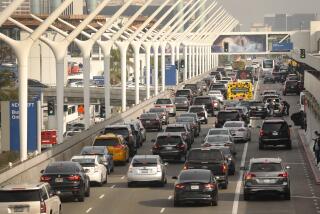Regional Airports Flying High
Bucking a national trend of declines in air travel, the Southland’s regional airports are experiencing a surge in passenger traffic, in some cases surpassing levels of before the Sept. 11, 2001, terrorist attacks.
Burbank Airport is handling 9.2% more travelers than a year ago, John Wayne Airport in Santa Ana 9.3% and Ontario International Airport 6.3%, according to the airports’ July data.
“Our passengers have gotten back their confidence in traveling by air,” said Victor J. Gill, spokesman for the Burbank-Glendale-Pasadena Airport Authority. “It’s part of the pattern of getting back into the realm of normalcy.”
The region’s smaller airports stand in contrast to others across the country, where the industry is still in a slump and passenger boardings dipped 1% compared with July last year, according to the Air Transport Assn., a trade group for major commercial carriers. Overall, passenger traffic on commercial airlines nationwide has plummeted 11.2% since July 2001.
The airline industry “has gone through an extremely turbulent time, an extremely painful time,” said Leonard Ginn, senior vice president of economic affairs for Airports Council International-North America, a trade group based in Washington, D.C.
The silver lining, he added, is that the monthly drop-off in passengers is now smaller than before, which could indicate an industrywide recovery around the corner.
In the meantime, such hubs as Los Angeles International Airport are still reeling from the aftershocks of an economic downturn as well as public fears stoked by 9/11, the SARS outbreak and the war in Iraq.
At LAX, 4% fewer passengers are passing through than a year ago, according to its June report, the most recent statistics available. Since June 2001, when LAX served 6 million fliers, passenger volume has nosedived 19%. This June, about 4.9 million passengers flew into or out of LAX.
Because many international carriers route flights through LAX and provide connections to other domestic destinations, the recent blows to international travel have also damaged the airport’s domestic market, said Paul Haney, spokesman for Los Angeles World Airports. International travel accounts for about a quarter of total passenger traffic at LAX.
Officials at the region’s other airports, which offer little or no international travel, say their operations were relatively unscathed by the SARS scare or overseas conflicts.
But that does not fully explain their hearty rebound. Elsewhere in the country, regional airports -- which offer many short- to medium-haul flights -- are still hurting, Ginn said.
According to airline industry statistics, the market for short-haul flights, or trips under 250 miles, has shrunk 24% since pre-9/11 days. The medium-haul market is mixed: Flights from 250 to 499 miles have fallen 12% and those 500 to 999 miles have grown 5%.
The strong presence of such financially healthy low-cost carriers as Southwest Airlines and JetBlue Airways may help explain the increases at the Southland’s smaller airports, Ginn said.
That’s certainly true for Long Beach Airport. Its monthly passenger traffic since July 2001 has ballooned nearly sixfold, to more than 290,000 travelers, thanks to the entrance of JetBlue into its market shortly before 9/11.
“The last two years are an anomaly,” said Sharon Diggs-Jackson, spokeswoman for Long Beach Airport, citing JetBlue’s phenomenal success as well as the fact that future passenger traffic would be limited because the airport has a cap on the number of flights. “We’re at the end of our growth cycle.”
Southwest Airlines has the largest market share at Burbank, John Wayne and Ontario, but officials at those airports also have other theories for their gains.
Gill, the Burbank Airport spokesman, said the authority’s new low long-term and valet parking rates may be helping attract more passengers. Burbank’s prices are now nearly half what they were a year ago because of competition from a large, privately run lot nearby.
About 426,000 passengers passed through Burbank’s gates last month, 2.7% more than in July 2001, according to a preliminary report.
John Wayne Airport, which surpassed its pre-9/11 passenger traffic levels more than a year ago, served 814,000 travelers last month -- 12.1% more than July 2001. Spokeswoman Ann McCarley attributed the increase to “the strong economy of Orange County.”
Ontario, which served 618,000 passengers last month, is still 4.6% lower than pre-9/11 levels. But traffic volumes are rising because travelers could be turning away from the long lines and other big-airport hassles of LAX, said spokeswoman Maria Fermin.
“We’re an alternative airport,” she said.
More to Read
Inside the business of entertainment
The Wide Shot brings you news, analysis and insights on everything from streaming wars to production — and what it all means for the future.
You may occasionally receive promotional content from the Los Angeles Times.










